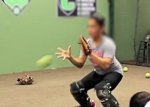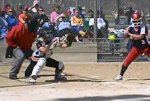As far as the high squat, that is something I simply disagree with from testing it with my girls....We had each girl go through blocking, throwing, timed into their throwing positions, and LIVE framing. These were girls from the age of 8-18. Most notable: 1) not one girl's pop time was decreased, not one 2) we had 2 live pitchers, both complained about the high squat 3) girl with the high squat got beat in a blocking race every time.... girl's complained about pain on the tops of their knee caps and inner knees.
I'm left with the impression that Jen's girls were attempting something new with the "High Squat" or runner on stance and may not have had much time working with this stance. It's important to understand that when any new techniques is attempted, muscles are stretched and there may be some discomfort or pain as you get used to what you're doing. This can be compounded if you are not taught to utilize the technique correctly. Under these circumstances the results are not surprising. There were other comments about high stance compared to low stance effectiveness for blocking as well. As for pitchers complaining about the stance. If they had not seen it before, it is something unfamiliar and anything new will make a pitcher uncomfortable at first. Catchers attempting to catch live pitching in an unfamiliar stance will be adjusting and moving and will distract the pitcher as well. At my DD's 18U Northern Nationals in Michigan a few years back, the starting pitcher requested my DD to pitcher for her in the semi finals, even though it wasn't my DD's turn to catch in the rotation...
As for blocking from hi and low stances, one of my catchers had the unique experience to become very proficient at blocking from her runner on stance. She attended the Tennessee Vol's Jr. camp and after her first block the coaches pulled her out and brought her in front of the entire group. The coaches proceeded to have her block again in front of the entire class of catchers and explain that they wanted each and every catcher there to block the EXACT SAME WAY! (I got a phone call that night from a very excited and proud mom!) This same catcher went on to catch for a team that would not allow her to use her runner on stance so she spent the season blocking from her low stance. She got proficient at BOTH types of blocking. So I timed her dropping and blocking from a low hip stacne and her runner on stance.
Please see Catcher Myth #53 Catchers should set up in a low stance... for the full video, times and explanation. Long story short is that for someone proficient at both styles of blocking, blocking from the runner on stance is notably quicker. Not only are they quicker, they are better able to control where the ball goes after the block and be prepared to throw a stealing runner out. The other issue is throwing hand safety... Notice how the throwing hand is left exposed to a foul tip or errant ball while blocking from the low hip stance....






